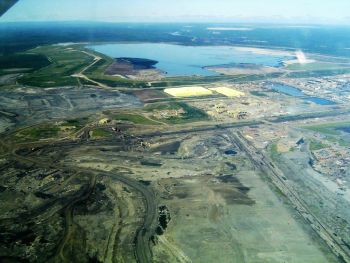Waste Management: Difference between revisions
No edit summary |
No edit summary |
||
| Line 6: | Line 6: | ||
|image= | |image= | ||
<!-- Add image file name --> | <!-- Add image file name --> | ||
tailings-alberta.jpg | |||
|link= | |link= | ||
| Line 13: | Line 13: | ||
|caption= | |caption= | ||
<!-- Add picture caption --> | <!-- Add picture caption --> | ||
Syncrude Tailings Dam, Fort McMurray, Alberta ([https://en.wikipedia.org/wiki/Tailings_dam Wikipedia]) | |||
}} | }} | ||
| Line 19: | Line 19: | ||
“Tailings are a by-product of mining, consisting of the processed rock or soil left over from the separation of the commodities of value from the rock or soil within which they occur. If they are not managed in a safe, responsible manner, tailings can pose risks to the environment, human health, and infrastructure. In cases where tailings are managed in purpose built (i.e., engineered) facilities, management of the integrity of these facilities is critically important”.<ref name="ICMM">[[Tailings Management: Good Practice Guide| Tailings Management: Good Practice Guide, ICMM, 2021]]</ref> | “Tailings are a by-product of mining, consisting of the processed rock or soil left over from the separation of the commodities of value from the rock or soil within which they occur. If they are not managed in a safe, responsible manner, tailings can pose risks to the environment, human health, and infrastructure. In cases where tailings are managed in purpose built (i.e., engineered) facilities, management of the integrity of these facilities is critically important”.<ref name="ICMM">[[Tailings Management: Good Practice Guide| Tailings Management: Good Practice Guide, ICMM, 2021]]</ref> | ||
“Most tailing facilities are planned, designed, constructed, operated, and closed in a safe and responsible manner. However, as recent failure incidents clearly indicate, the physical [[stability]] of tailings facilities has not been universal. Global performance needs to improve”.<ref name="ICMM"></ref> | “Most tailing facilities are planned, designed, constructed, operated, and closed in a safe and responsible manner. However, as recent failure incidents clearly indicate, the physical [[stability]] of tailings facilities has not been universal. Global performance needs to improve”.<ref name="ICMM"></ref> | ||
Revision as of 22:47, 23 November 2022

|
| Syncrude Tailings Dam, Fort McMurray, Alberta (Wikipedia) |
Some dams are used to help manage or provide long-term storage of industrial waste materials. At mining facilities, these are referred to as tailings dams. Such structures can be designed to keep waste from seeping into or damaging the surrounding environment.
“Tailings are a by-product of mining, consisting of the processed rock or soil left over from the separation of the commodities of value from the rock or soil within which they occur. If they are not managed in a safe, responsible manner, tailings can pose risks to the environment, human health, and infrastructure. In cases where tailings are managed in purpose built (i.e., engineered) facilities, management of the integrity of these facilities is critically important”.[1]
“Most tailing facilities are planned, designed, constructed, operated, and closed in a safe and responsible manner. However, as recent failure incidents clearly indicate, the physical stability of tailings facilities has not been universal. Global performance needs to improve”.[1]
Best Practices Resources
![]() Tailings Management: Good Practice Guide (International Council on Mining and Metals)
Tailings Management: Good Practice Guide (International Council on Mining and Metals)
![]() Global Industry Standard on Tailings Management (International Council on Mining and Metals)
Global Industry Standard on Tailings Management (International Council on Mining and Metals)
Citations:
Revision ID: 4581
Revision Date: 11/23/2022
